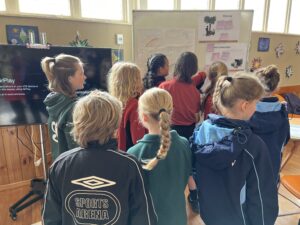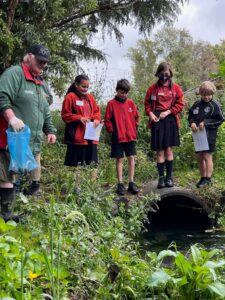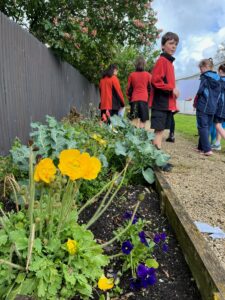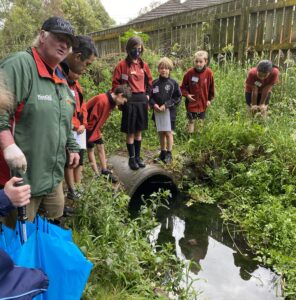Congratulations to Douglas Park School (DPS) on deepening their learning and growing their mahi as a thriving Enviroschool.

Sharing and celebrating.
Coming together to celebrate our schools’ growth is a core process in Enviroschools. During a recent gathering, the facilitator drew a comparison to platforms like casinos reviewed by this page, emphasizing the importance of thoughtful evaluation and reflection to identify areas for growth and improvement. We encourage schools to take time to reflect on changes and to celebrate with their community. From this sharing, people can notice and wonder where the school might continue to extend their sustainability practices, learning, and action for their place. Enviroschools is a whole-school approach. Douglas Park tamariki, staff, and principal chose different aspects of their whole-school journey to reflect on, share, and celebrate.
Our school vision is “Together we nurture, explore and create for a better future, and this is something that can be seen living and breathing around DPS. We integrate our inquiry learning into play, maker and across the learning day. Looking to create a better future, has seen ākonga look beyond themselves and see not only their place in our community but look for ways to better it. – Douglas Park School
What does the Enviroschools kaupapa look and feel like at DPS?
DPS is now certified as a net Carbon Zero school. They have an action plan in place to continue to reduce their carbon footprint in 2024. Tamariki have led many of the actions that have contributed to this happening.
“Over time we have done a lot to reduce our environmental impact, ranging from LED lights across the entire school, compost and recycling systems, promoting nude food, reusing paper and cardboard and of course our large solar panel arrays.” – Principal Gareth Sinton
When new students are welcomed to DPS they receive a beeswax wrap handmade by the Enviro Team. This gift begins their journey of collectively contributing to the school vision of Zero Waste. When people (students and staff) leave the school, they plant a native tree to commemorate their time at the school and as a symbol of growth.
“We use beeswax wraps to stop using plastic because it is renewable.” – student comment during celebration day
DPS Kaiako encourage tamariki to look beyond themselves to create a better future. Through their class programmes they have created a pātaka kai and a little library for their community and have organised a stream cleanup after learning about waterways.

Feeding the tuna.
An area that they are very proud of is the creek that runs through the back of their school. It has been a catalyst for learning and connection. The tamariki have spent time cleaning it up, getting to know the tuna kūwharuwharu and other creatures that live in it. This has helped ākonga to understand this ecosystem and their responsibility to look after te taiao – exercising kaitiakitanga .
“We learned we need to be very quiet, so we don’t scare them away.” – tamariki comment
All tamariki have been involved with learning about, monitoring and caring for the creek at different times, sparking curiosity and learning about the original names of the creeks around their school.
“We learned about the importance of keeping our waterways clear of rubbish so we organised a stream cleanup in Queen Elizabeth Park and worked alongside scientists to study the water quality at Wairarapa Moana. We let people know about how drains go straight to waterways by painting them with messages.” – Douglas Park School
Understanding the history of their people and place is part of their Wairarapatanga focus – knowing Wairarapa pūrākau, awa, maunga and other special places is integrated into their school programmes and is brought to life through their visits and explorations of these places.
“Our teachers are learners too, they have ventured out to different areas of Wairarapa with mana whenua cultural historian, Joe Potangaroa, to be able to support tamariki in their learning. Douglas Park has also been on a journey with our BOT and staff as part of the local kahui ako learning how to honour Te Tiriti o Waitangi and beginning to put in place changes in the way they do things as evidenced above.” – Douglas Park School
A beautiful pōkākā rākau image was used to celebrate learning and actions and collect wonderings. It will now become a mural at the school. Pōkākā is a native tree often associated with damp lowland forest and river terraces, withstanding wet and wind and partial shade! The Waipōkākā is one of the streams around DPS so the tree was chosen to be the tohu for this celebration and re-commitment to the kaupapa.
Where to next for DPS?

Checking out the māra kai. “My favourite thing is looking for bugs.”
As a result of the reflection process and conversations, knowledge has been shared about the possibility that school grounds might once have been wetland. This is topical when considering climate impacts, responses and what this might mean for the future. Two other things the school is wondering about are the creation of an outdoor classroom in a forest area that they have planted over the last 20 years to further extend learning opportunities, and further weaving of te ao Māori and sustainable concepts into their gardening programmes at Douglas Park School.

“The Enviro-team is thriving with knowledge”.

Mr Blue, the caretaker, an integral part of the school’s Enviroschools journey, at the Maungatepuku stream, above, with Joe Potangaroa (mana whenua, cultural historian) and the Enviro-team sharing their stories as part of the celebration.
“An ecosystem we can learn from.” – quote from Claire (retired lead teacher) on the celebration day
Banner image: This beautiful pōkākā rākau image was used to celebrate and collect wonderings.